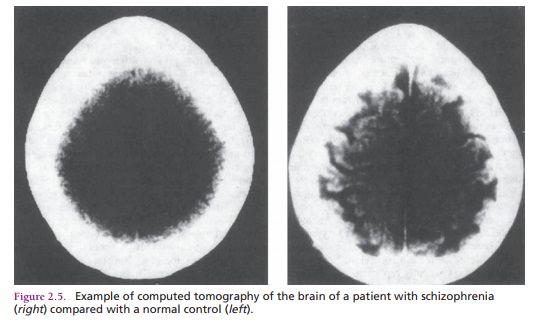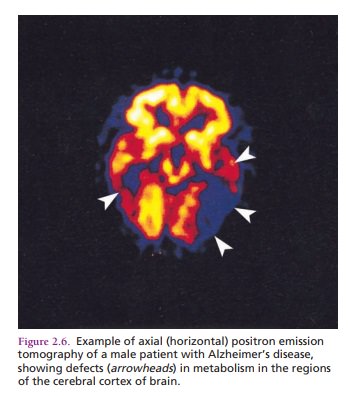Chapter: Psychiatric Mental Health Nursing : Neurobiologic Theories and Psychopharmacology
Types of Brain Imaging Techniques

Types of Brain Imaging Techniques
Computed tomography (CT), also called computed axial tomography (CAT), is a procedure in which a precise x-ray beam takes cross-sectional images (slices) layer by layer. A computer reconstructs the images on a monitor and also stores the images on magnetic tape or film. CT can visualize the brain’s soft tissues, so it is used to diagnose primary tumors, metastases, and effusions and to determine the size of the ventricles of the brain. Some people with schizophre-nia have been shown to have enlarged ventricles; this finding is associated with a poorer prognosis and marked negative symptoms (Figure 2.5;) The person under-going CT must lie motionless on a stretcher-like table for about 20 to 40 minutes as the stretcher passes through a tunnel-like “ring” while the serial x-rays are taken.

In magnetic resonance imaging (MRI), a type of body scan, an energy field is created with a huge magnet andradio waves. The energy field is converted to a visual image or scan. MRI produces more tissue detail and contrast than CT and can show blood flow patterns and tissue changes such as edema. It also can be used to measure the size and thickness of brain structures; persons with schizophrenia can have as much as 7% reduction in cortical thickness. The person undergoing an MRI must lie in a small, closed chamber and remain motionless during the procedure, which takes about 45 minutes. Those who feel claustro-phobic or have increased anxiety may require sedation before the procedure. Clients with pacemakers or metal implants, such as heart valves or orthopedic devices, can-not undergo MRI.
More advanced imaging techniques, such as positron emission tomography (PET) and single photon emission computed tomography (SPECT), are used to examine the function of the brain. Radioactive substances are injected into the blood; the flow of those substances in the brain is monitored as the client performs cognitive activities as instructed by the operator. PET uses two photons simul-taneously; SPECT uses a single photon. PET provides better resolution with sharper and clearer pictures and takes about 2 to 3 hours; SPECT takes 1 to 2 hours. PET and SPECT are used primarily for research, not for the diagnosis and treatment of clients with mental disorders (Fujita, Kugaya, & Innis, 2005; Vythilingam et al., 2005) (Figure 2.6). A recent breakthrough is the use of the chemical marker FDDNP with PET to identify the amy-loid plaques and tangles of Alzheimer’s disease in living clients; these conditions previously could be diagnosed only through autopsy. These scans have shown that cli-ents with Alzheimer’s disease have decreased glucose metabolism in the brain and decreased cerebral blood flow. Some persons with schizophrenia also demonstrate decreased cerebral blood flow.

Related Topics